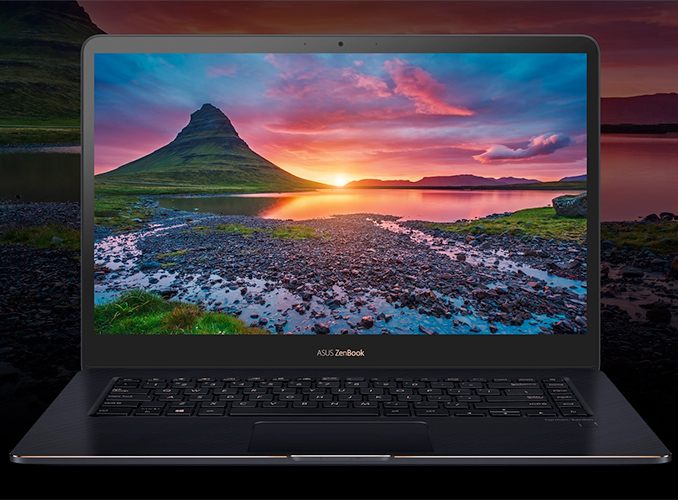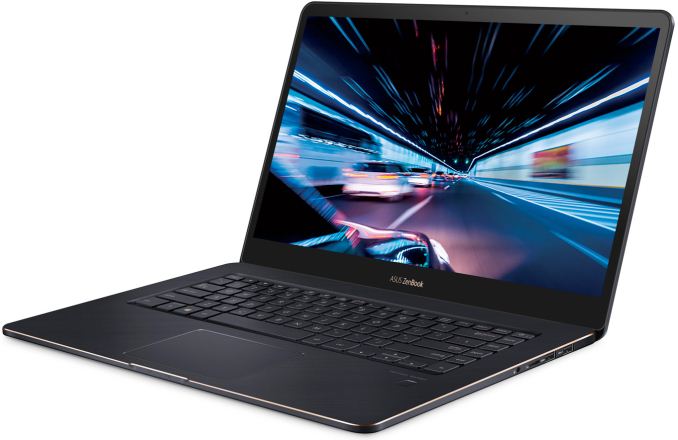ASUS ZenBook Pro 15 UX550GE Laptop with Core i7 & 4K LCD Is Now Available
by Anton Shilov on August 7, 2018 2:00 PM EST- Posted in
- Laptops
- Asus
- Zenbook
- Pascal
- Coffee Lake-H
- ZenBook Pro
- ZenBook Pro 15

ASUS has started selling its 15-inch ZenBook Pro 15 UX550GE ultra-thin laptop featuring Intel’s six-core processor, NVIDIA’s discrete GPU as well as a factory-calibrated 15.6-inch display with a 4K Ultra-HD resolution. The laptop is available in only one configuration, but good news is that it is relatively affordable as it costs less than $2000.
The ASUS ZenBook Pro 15 UX550GE-XB71T is based on Intel’s six-core Core i7-8750H processor accompanied by 16 GB of DDR4-2400 memory as well as a 512 GB NVMe SSD. The laptop has NVIDIA’s GeForce GTX 1050 Ti GPU with 4 GB of memory that drives its 15.6-inch multi-touch IPS display featuring a 3840×2160 resolution and is factory-calibrated to a Delta-E <2 accuracy.
The latest ASUS ZenBook Pro 15 comes in ‘Deep Dive Blue’ aluminum unibody with rose gold edges to highlight its first-class nature and positioning. The laptop features an 18.9-mm z-height and weighs 1.86 kilograms, thus being thinner and lighter than most 15.6-inch laptops. As for battery life, the notebook can work for 9.5-hours on one charge (according to MobileMark 2014) on its 71 Wh lithium-polymer battery.
On the wireless connectivity side of things, we see Intel’s Wireless-AC 9560 CNVi solution featuring 802.11ac Wi-Fi (with up to 1.73 Gbps throughput) and Bluetooth 5.0. As for physical connectors, the notebook is equipped with two Thunderbolt 3 ports, two USB 3.1 Gen 2 headers, an HDMI display output, a microSD card reader, a TRRS audio jack, and a proprietary jack for charging. As for conferencing, the laptop has a VGA webcam, Harman Kardon-badged stereo speakers, and a microphone array.
The ASUS ZenBook Pro 15 UX550GE-XB71T notebook is available directly from ASUS in the U.S. as well as from large retailers like Amazon and Newegg. The laptop costs $1,799, but eventually ASUS may expand the number of configurations and introduce models that are more affordable (Core i5-8300H-based) or more expensive (Core i9-based).
| General Specifications of the ASUS ZenBook Pro 15 UX550 | ||
| UX550GE-XB71T | ||
| LCD | Diagonal | 15.6" |
| Details | 3840×2160 | 100% AdobeRGB, 95% NTSC | |
| Multi-Touch | 10-point multi-touch | |
| CPU Options | Core i7-8750H (6C/12T) | |
| Graphics | Integrated | HD Graphics 630 (24 EUs) |
| Discrete | NVIDIA GeForce GTX 1050 Ti 4 GB GDDR5 memory |
|
| RAM | 16 GB DDR4-2400 (soldered) | |
| Storage | SSD | 512 GB PCIe 3.0 x4/NVMe |
| Wireless | Wi-Fi | Intel Wireless-AC 9560 CRF 802.11ac (2x2) Wi-Fi |
| Bluetooth | Bluetooth 5.0 | |
| USB | 3.1 Gen 2 | 2 × TB 3 (Type-C) 2 × USB Type-A |
| Thunderbolt | 2 × TB 3 (data, DP displays) | |
| Display Outputs | 1 × HDMI 2 × TB3 with DisplayPort |
|
| Gigabit Ethernet | Optional via a dongle | |
| Card Reader | Micro SD card reader | |
| Webcam | VGA webcam | |
| Fingerprint Sensor | Yes | |
| Other I/O | Microphone, stereo speakers, audio jack | |
| Battery | 71 Wh | |
| Dimensions | Width | 36.5 cm | 14.37 inch |
| Depth | 25.1 cm | 9.88 inch | |
| Thickness | 1.89 cm | 0.74 inch | |
| Weight | 1.86 kilograms | 4.1 lbs | |
| Price | $1,799 | |
Related Reading
- ASUS Unveils Ultra-Thin ZenBook Pro 15 with Six-Core Core i9, GTX 1050, Calibrated 4K LCD
- The ASUS ZenBook 3 Review: A Convincing Case for Quad Core Thin & Light Laptops
- ASUS ZenBook 3 Deluxe UX490UA: Kaby Lake, 16 GB RAM, 1 TB SSD, TB3, 14" FHD, 2.4 lbs
- HP EliteBook 1050 G1: Six-Core CPU, NVIDIA GPU, RAID, 15.6-inch 4K LCD
- MSI Announces GS65 Stealth: Thin & Lighter 15-Inch Gaming Laptop
- Samsung Odyssey Z Gaming Notebook: Going For Gamers with 8th Gen and Max-Q
- Origin PC Evo15-S Gaming Laptop: Core i7, GTX 1070 Max-Q, 1080p144
- ASUS Announces the Zenbook 3: A Macbook Competitor with Core i7, 16GB DRAM and 1TB SSD
- ASUS Announces the ZenBook Pro UX501
Source: ASUS



















13 Comments
View All Comments
Optimummind - Tuesday, August 7, 2018 - link
For that price, a GeForce GTX 1060 (non-MaxQ) should've been the minimum, IMO.DanNeely - Tuesday, August 7, 2018 - link
Looking at similar specced models (i7, 1050Ti, 15" 4k, 16GB, 512 GB) the cheaper HP models are significantly thicker/somewhat heavier roughly 1" vs 0.7", Lenovo has a model that's a much closer match selling at $1680 discounted from a $1849 MSRP. That suggests that once the it's new so we're not going to discount it at all period is past the Asus should be a lot closer to it in price. And while still relatively fat the HP Omen is the only premium segment model (pavilion's are a mainstream model) is also $1700.And in the ultra-thin category I think there's a lot to be said for staying with lower TDP models to keep temperatures/fan volumes down.
https://www.newegg.com/Product/ProductList.aspx?Su...
satai - Tuesday, August 7, 2018 - link
Nvidia card totally kills it for me :-/Both Intel and AMD create drivers of reasonable quality but both Nvidia and Noveau are sadly not worth the troubles.
Spunjji - Wednesday, August 8, 2018 - link
Interesting. In my experience Intel's drivers have consistently been the worst I've encountered, excepting now-defunct companies like S3.satai - Thursday, August 9, 2018 - link
Intel keeps them OSS and they are in mainline kernels. Very little problems so far.(Speaking about up-to date Core CPUs, not old Atoms etc.)
cosmotic - Tuesday, August 7, 2018 - link
DC input? not USB PD? =(DanNeely - Tuesday, August 7, 2018 - link
USB-PD can't deliver enough power to keep it from draining the battery while gaming and plugged into the wall. It tops out at 100W, this has a 45W cpu, 64W GPU (both higher as long as they're running above base clocks), and a few more watts to run rest of the system at load.doggface - Wednesday, August 8, 2018 - link
Um. Thats not how those numbers work. You are quoting TDP.It has a 71w battery which takes just under 10 hrs to drain on that mobile mark test. That means it has an average power draw of 7.1-7.5 watts/hr. This will likely come with a 45 or 65 watt charger so it can charge and run at the same time. Well within USB-PD spec.
erinadreno - Wednesday, August 8, 2018 - link
Manufactures usually design their PSU at greater than the combined TDP of all components, unless it's Apple. The peak TDP of CPU is usually 65W on windows laptops, while GPU compromises its power whenever necessary. If ASUS keeps its design, the PSU would be 130W, only Dell managed to make a type-c PSU (non USB-PD) with that much power.Teckk - Tuesday, August 7, 2018 - link
The right number of ports, thank you!